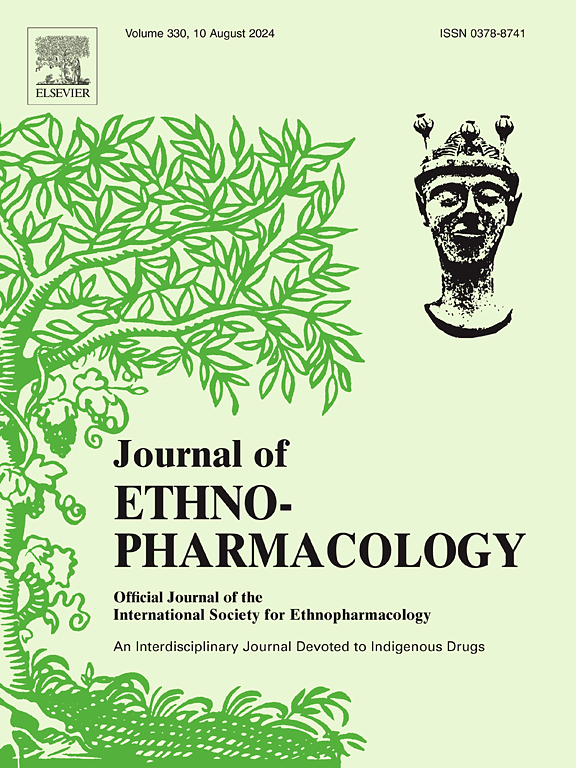Anticonvulsant effect of Stachydrine on pentylenetetrazole-induced kindling seizure mouse model via Notch and NMDAR signaling pathways
IF 4.8
2区 医学
Q1 CHEMISTRY, MEDICINAL
引用次数: 0
Abstract
Ethnopharmacological relevance
Stachydrine (STA), the principal bioactive alkaloid of Leonurus japonicus (Motherwort/"Yi Mu Cao"), may derive its ethnopharmacological relevance for epilepsy management from the botanical origin-Motherwort's documented traditional use in treating seizures and other neurological cardiovascular diseases.
Aim of the study
To validate STA's ethnomedicinal claim an anticonvulsant by mechanistically interrogating its dual modulation of Notch1-driven neuroinflammation and NMDA receptor-mediated excitotoxicity, which are two key hallmarks of chronic epileptogenesis.
Materials and methods
Male C57BL/6 mice were divided into three groups to evaluate the neuroprotective and an anticonvulsant effects of STA in the PTZ-induced seizure model: Control group, PTZ group, and PTZ + STA group. Behavioral seizure scoring and cognitive tests were integrated with EEG recordings to assess neuronal synchronization. Molecular mechanisms were dissected via hippocampal immunohistochemistry and Western blotting.
Results
Our results showed that daily oral administration of STA for a duration of 25 days significantly reduced seizure scores. EEG recordings indicated that STA treatment resulted in a notable reduction in both total brainwave power and firing amplitude within the groups receiving STA. Furthermore, STA administration provided cognitive protection against kindling-associated deficits, as demonstrated by improved alteration behavior and recognition index in Y-maze and object recognition tests. STA administration reduced neuronal loss and glial cell activation. Additionally, significant downregulation of NMDA receptor subunits, CAMK2, caspase-3, Notch1, and Hes1 expression levels was observed following STA administration.
Conclusion
These findings suggest that STA provides neuroprotection against PTZ-induced epilepsy by modulating the Notch and NMDA receptor pathways, thus addressing neuroinflammation and apoptosis resulting from excitotoxicity.
水仙碱通过Notch和NMDAR信号通路对戊四唑点燃性癫痫小鼠模型的抗惊厥作用。
民族药理学意义:益母草(益母草/“益母草”)的主要生物活性生物碱——水仙碱(STA),其与癫痫治疗的民族药理学意义可能源于益母草的植物来源——益母草在治疗癫痫发作和其他神经心血管疾病方面的传统用途。研究目的:通过对STA的双重调节notch1驱动的神经炎症和NMDA受体介导的兴奋性毒性(慢性癫痫发生的两个关键标志)的机制研究,验证STA的民族医学声明是一种抗惊厥药。材料与方法:将雄性C57BL/6小鼠分为三组:对照组、PTZ组和PTZ+STA组,观察STA对PTZ致痫模型的神经保护和抗惊厥作用。行为癫痫评分和认知测试与脑电图记录相结合,以评估神经元同步。通过海马免疫组织化学和Western blotting分析其分子机制。结果:我们的研究结果表明,每天口服STA持续25天显著降低癫痫发作评分。脑电图记录显示,STA治疗导致接受STA治疗组的总脑波功率和放电幅度显著降低。此外,通过改善y迷宫和物体识别测试中的改变行为和识别指数,STA对引燃相关缺陷提供了认知保护。STA可减少神经元丢失和胶质细胞活化。此外,STA给药后,NMDA受体亚基、CAMK2、caspase-3、Notch1和Hes1的表达水平显著下调。结论:STA通过调节Notch和NMDA受体通路,对ptz诱导的癫痫提供神经保护,从而解决兴奋性毒性引起的神经炎症和细胞凋亡。
本文章由计算机程序翻译,如有差异,请以英文原文为准。
求助全文
约1分钟内获得全文
求助全文
来源期刊

Journal of ethnopharmacology
医学-全科医学与补充医学
CiteScore
10.30
自引率
5.60%
发文量
967
审稿时长
77 days
期刊介绍:
The Journal of Ethnopharmacology is dedicated to the exchange of information and understandings about people''s use of plants, fungi, animals, microorganisms and minerals and their biological and pharmacological effects based on the principles established through international conventions. Early people confronted with illness and disease, discovered a wealth of useful therapeutic agents in the plant and animal kingdoms. The empirical knowledge of these medicinal substances and their toxic potential was passed on by oral tradition and sometimes recorded in herbals and other texts on materia medica. Many valuable drugs of today (e.g., atropine, ephedrine, tubocurarine, digoxin, reserpine) came into use through the study of indigenous remedies. Chemists continue to use plant-derived drugs (e.g., morphine, taxol, physostigmine, quinidine, emetine) as prototypes in their attempts to develop more effective and less toxic medicinals.
 求助内容:
求助内容: 应助结果提醒方式:
应助结果提醒方式:


